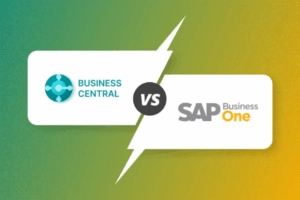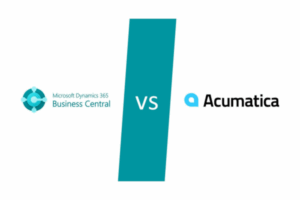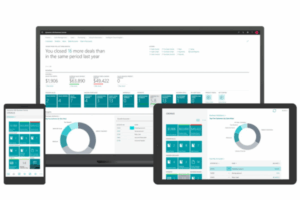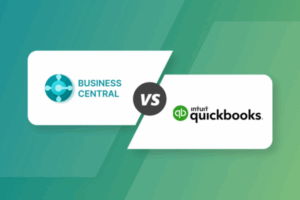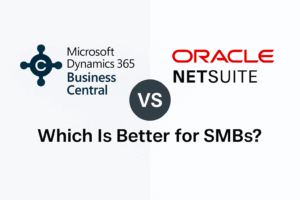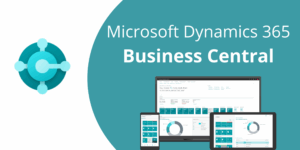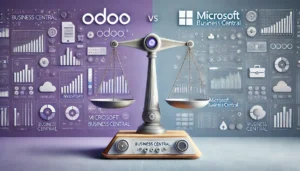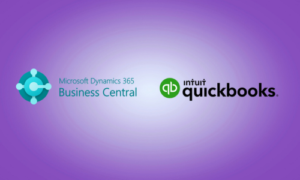Business Central vs SAP Business One: Quick Snapshot
| Category | Business Central | SAP Business One |
|---|---|---|
| Deployment | Cloud (Microsoft SaaS) or on-prem | Primarily on-prem, some hosted cloud options |
| Launch Year | 2018 (cloud-native design) | Early 2000s (client-server architecture) |
| Pricing Model | Subscription ($80–$110/user/month, Oct 2025) | Perpetual license or hosted subscription |
| Best For | SMBs using Microsoft 365, Power BI, Azure | Manufacturers or wholesalers preferring on-prem control |
| Integrations | Tight links with Outlook, Excel, Teams, Power BI | Integrates with SAP ecosystem and select third-party tools |
| Customization | Low-code via Power Platform and AL extensions | SDK-based, developer-heavy |
| Updates | Twice-yearly automatic cloud updates | Manual or partner-managed upgrades |
Business Central vs SAP Business One: Pros and Cons
Business Central Pros
-
Modern cloud ERP: Built for SaaS scalability and continuous updates.
-
Microsoft integration: Seamless with Excel, Outlook, Teams, and Power BI.
-
Low-code flexibility: Extend functionality using Power Apps and Power Automate.
-
Predictable pricing: Simple monthly subscription with no server costs.
-
Ideal for distributed or growing SMBs.
Business Central Cons
-
Requires consistent internet access for SaaS environments.
-
Limited native CRM without pairing with Dynamics 365 Sales or HubSpot.
-
Some industry-specific needs require third-party AppSource extensions.
SAP Business One Pros
-
Proven and mature: Reliable system with decades of functionality.
-
Strong inventory and production management for manufacturing.
-
Full on-prem control: Complete data ownership and server access.
-
Large partner network with experienced implementers worldwide.
SAP Business One Cons
-
Older tech foundation: Built for on-prem, not cloud-native.
-
Manual updates: Require IT or partner involvement.
-
Limited Microsoft integration.
-
Higher upfront costs for licenses, hardware, and maintenance.
Business Central vs SAP Business One: Cost Comparison
| Cost Factor | Business Central | SAP Business One |
|---|---|---|
| Licensing | $80–$110/user/month | Perpetual license (~$3,000/user) or hosted $150–$200/user/month |
| Implementation | $25K–$150K (varies by scope) | $35K–$175K (varies by customization) |
| Maintenance | Included in SaaS pricing | 17–22% of license cost annually |
| Hardware | None (cloud-hosted) | Required for on-prem installations |
Takeaway:
-
Business Central has lower upfront and predictable recurring costs.
-
SAP Business One may appear cheaper at purchase but grows costly with updates and infrastructure.
Business Central vs SAP Business One: Technology and Scalability
Business Central is designed for the modern SMB — always up to date, always connected, and easily integrated with the Microsoft ecosystem.
SAP Business One, while capable, relies on legacy infrastructure. It can be hosted in the cloud, but those setups are typically managed by partners, not SAP itself.
Verdict:
If you value agility, scalability, and seamless upgrades, Business Central wins.
If you need full control and have a strong internal IT team, SAP Business One remains serviceable.
Business Central vs SAP Business One: Implementation and Ease of Use
Business Central offers a clean, modern interface that looks familiar to anyone using Excel or Outlook making it faster for teams to adopt.
SAP Business One uses an older interface that can feel more rigid but offers powerful detail for advanced users.
Verdict: Business Central is easier to learn; SAP Business One is deeper but steeper.
Business Central vs SAP Business One: ROI and Long-Term Value
Across SMBs we’ve worked with, Business Central ROI typically appears within 12–24 months due to automation, analytics, and easier maintenance.
SAP Business One ROI often takes 18–30 months because of higher implementation and upgrade costs.
Long-term:
Business Central’s automatic updates and low-code flexibility make it better suited for companies planning to grow or expand internationally.
Which ERP Is Better for SMBs?
Ask yourself:
-
Are we ready to move fully to the cloud?
-
Do we already use Microsoft tools?
-
How important is scalability versus control?
-
Do we plan to expand globally or stay local?
If your business wants scalability, automation, and modern integration — Business Central is the stronger choice.
If you need stable, on-prem manufacturing control with limited IT change — SAP Business One can still deliver.
Wrapping it Up
When it comes to Business Central vs SAP Business One, both systems serve SMBs well, but for very different futures.
Business Central represents the modern cloud ERP era: agile, integrated, and continuously evolving.
SAP Business One represents legacy reliability: stable, proven, but limited in flexibility.
For SMBs focused on growth, automation, and future readiness, Business Central typically offers the stronger return.
At Alchemy 365, we help businesses evaluate ERP options honestly even when the right answer isn’t Business Central.



